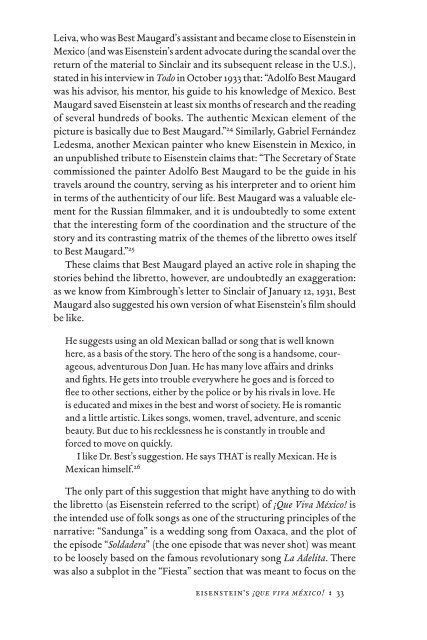In Excess: Sergei Eisentein's Mexico - Cineclub
In Excess: Sergei Eisentein's Mexico - Cineclub
In Excess: Sergei Eisentein's Mexico - Cineclub
You also want an ePaper? Increase the reach of your titles
YUMPU automatically turns print PDFs into web optimized ePapers that Google loves.
Leiva, who was Best Maugard’s assistant and became close to Eisenstein in<br />
<strong>Mexico</strong> (and was Eisenstein’s ardent advocate during the scandal over the<br />
return of the material to Sinclair and its subsequent release in the U.S.),<br />
stated in his interview in Todo in October 1933 that: “Adolfo Best Maugard<br />
was his advisor, his mentor, his guide to his knowledge of <strong>Mexico</strong>. Best<br />
Maugard saved Eisenstein at least six months of research and the reading<br />
of several hundreds of books. The authentic Mexican element of the<br />
picture is basically due to Best Maugard.” 24 Similarly, Gabriel Fernández<br />
Ledesma, another Mexican painter who knew Eisenstein in <strong>Mexico</strong>, in<br />
an unpublished tribute to Eisenstein claims that: “The Secretary of State<br />
commissioned the painter Adolfo Best Maugard to be the guide in his<br />
travels around the country, serving as his interpreter and to orient him<br />
in terms of the authenticity of our life. Best Maugard was a valuable element<br />
for the Russian fi lmmaker, and it is undoubtedly to some extent<br />
that the interesting form of the coordination and the structure of the<br />
story and its contrasting matrix of the themes of the libretto owes itself<br />
to Best Maugard.” 25<br />
These claims that Best Maugard played an active role in shaping the<br />
stories behind the libretto, however, are undoubtedly an exaggeration:<br />
as we know from Kimbrough’s letter to Sinclair of January 12, 1931, Best<br />
Maugard also suggested his own version of what Eisenstein’s fi lm should<br />
be like.<br />
He suggests using an old Mexican ballad or song that is well known<br />
here, as a basis of the story. The hero of the song is a handsome, courageous,<br />
adventurous Don Juan. He has many love affairs and drinks<br />
and fi ghts. He gets into trouble everywhere he goes and is forced to<br />
fl ee to other sections, either by the police or by his rivals in love. He<br />
is educated and mixes in the best and worst of society. He is romantic<br />
and a little artistic. Likes songs, women, travel, adventure, and scenic<br />
beauty. But due to his recklessness he is constantly in trouble and<br />
forced to move on quickly.<br />
I like Dr. Best’s suggestion. He says THAT is really Mexican. He is<br />
Mexican himself. 26<br />
The only part of this suggestion that might have anything to do with<br />
the libretto (as Eisenstein referred to the script) of ¡Que Viva México! is<br />
the intended use of folk songs as one of the structuring principles of the<br />
narrative: “Sandunga” is a wedding song from Oaxaca, and the plot of<br />
the episode “Soldadera” (the one episode that was never shot) was meant<br />
to be loosely based on the famous revolutionary song La Adelita. There<br />
was also a subplot in the “Fiesta” section that was meant to focus on the<br />
eisenstein’s ¡que viva méxico! : 33


